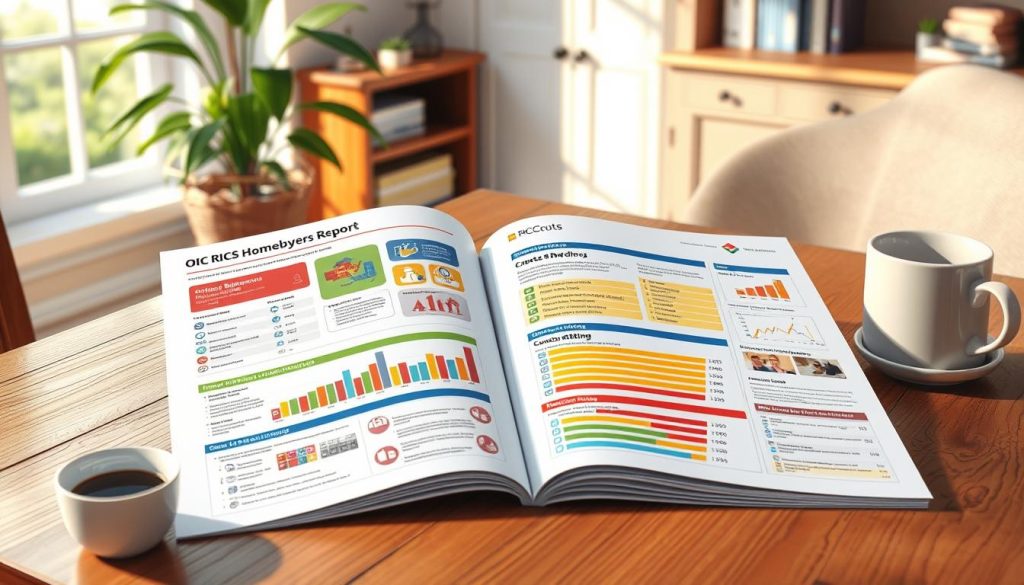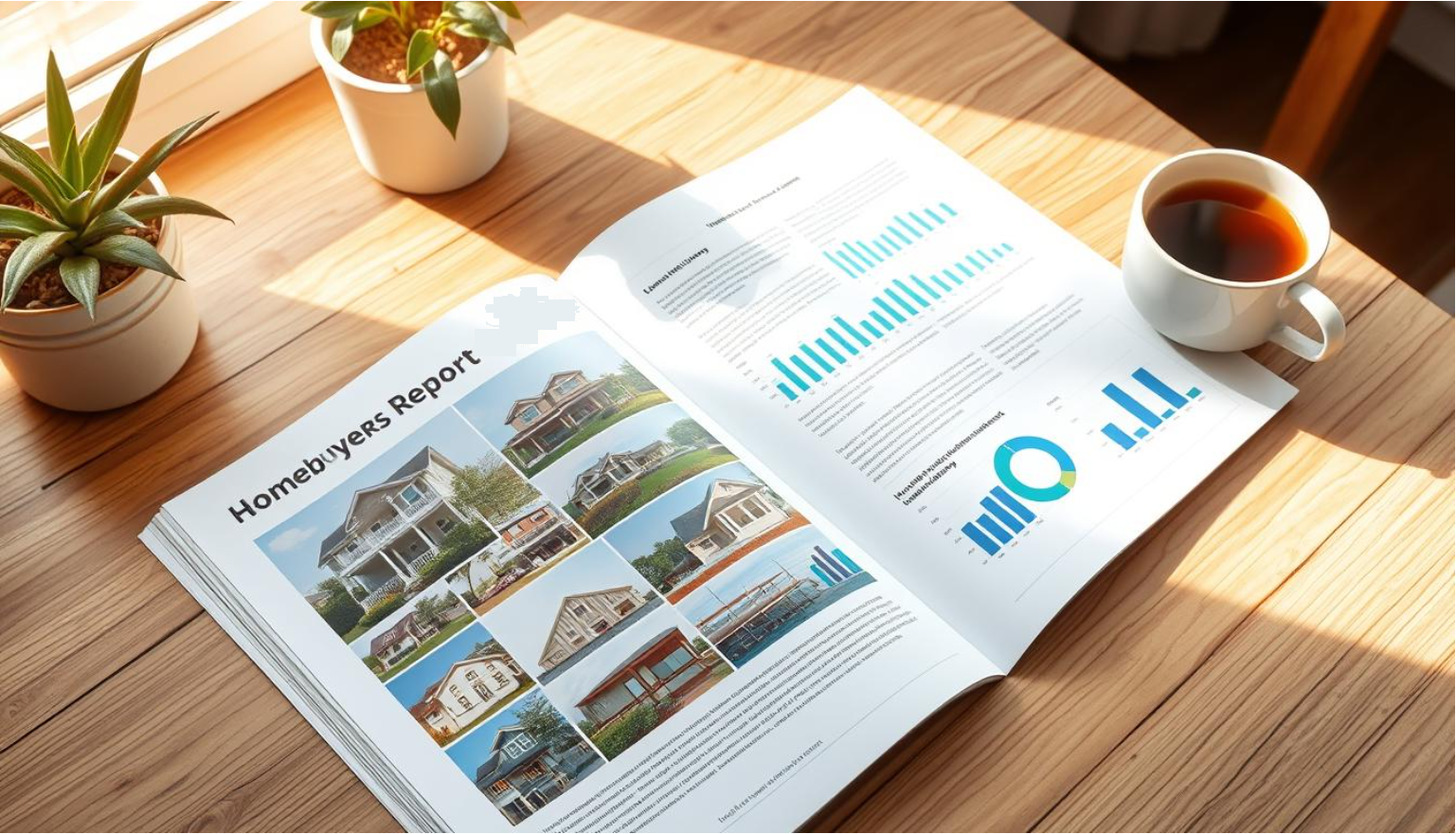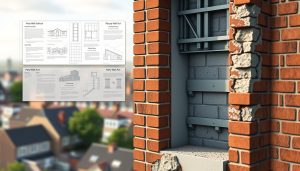Acquiring a homebuyers report is imperative for prospective homeowners, given the prevalence of conventional properties in satisfactory condition necessitating such evaluations. The Royal Institution of Chartered Surveyors (RICS) regulates over 130,000 chartered surveyors in the UK, guaranteeing adherence to stringent survey standards. However, there are equivalent regulatory bodies such as Chartered Institute of Building (CIOB) and Residential Property Surveyors Association (RPSA).
A homebuyers report serves as a critical tool, enabling buyers to uncover latent issues within a property. This can significantly influence the purchase price, potentially reducing it by 10-15% during negotiations. Approximately 70% of those who have undergone a survey report enhanced confidence in the property’s condition post-evaluation. Typically, the HomeBuyers Report is delivered within 2-3 days following the survey’s initiation.
Key Takeaways
- A homebuyers report is recommended for approximately 80% of conventional properties in reasonable condition.
- Properties with identified significant issues may see a 10-15% reduction in purchase price during negotiations.
- About 70% of homebuyers who commissioned a survey reported peace of mind regarding the property’s condition post-survey.
- The average time to receive a HomeBuyers Report is typically 2-3 days after commissioning the survey.
- A homebuyers report can help buyers identify potentially problematic aspects of the property, facilitating more informed decision-making.
- Property surveys, encompassing homebuyers reports, are indispensable for ensuring that buyers are fully appraised of a property’s condition prior to acquisition.
- Roughly 60% of buyers deem the thoroughness of the HomeBuyers Report as a decisive factor in their purchasing deliberations.
Understanding the RICS Homebuyers Report Format
The RICS Homebuyers Report offers a detailed examination of a property’s condition, encompassing an in-depth analysis of its upkeep requirements and possible flaws. It is a critical tool for prospective homeowners, enabling them to make well-informed decisions regarding their investment. This report, akin to a home survey, involves a physical inspection and a valuation assessment, providing a transparent view of the property’s condition and its market worth.
The report is structured into distinct sections, each dedicated to a particular facet of the property. These segments encompass evaluations of the property’s exterior and interior, its services, and its grounds. A valuation component is also included, furnishing an estimate of the property’s market value. The RICS Homebuyers Report employs a traffic light rating system to classify the condition of various property elements, facilitating buyers in identifying any prospective issues.
Standard Sections and Layout
The RICS Homebuyers Report’s standard sections and layout comprise:
- Introduction to the property and the report’s purpose
- An account of the property’s condition, detailing any defects or issues
- A valuation of the property, including an estimate of its market value
- Conclusion and recommendations for the buyer
Property Valuation Components
The valuation components of the RICS Homebuyers Report encompass assessments of the property’s:
- Market value (if requested)
- Rental value (if requested)
- Renovation or improvement possibilities
By grasping the RICS Homebuyers Report’s format, buyers can make informed decisions about their purchase, sidestepping possible pitfalls. The report offers a thorough overview of the property’s condition and value, equipping buyers with the necessary information to negotiate a fair price and plan for any necessary repairs or maintenance.
| Condition Rating | Description |
|---|---|
| 1 | No repair currently needed; maintenance must continue as normal |
| 2 | Defects that need repair or replacement but are not considered serious or urgent |
| 3 | Defects that are serious and require urgent attention |
| NI | Elements not inspected (due to limited access/visibility) |
Key Features of a Professional Homebuyers Report Example
A professional homebuyers report exemplifies a critical property valuation and building survey, indispensable for buyers contemplating property acquisition. It encompasses a meticulous evaluation of the property’s state, pinpointing any defects or issues that could influence its valuation or necessitate remedial actions.
The report’s structure typically encompasses an introduction, inspection particulars, and a conclusive opinion and summary. It extends to encompass property valuation and assigns a condition rating to various property components, such as the roof, walls, and floors. This data is vital for assessing the property’s worth and pinpointing any factors that could diminish its resale value.
Some of the salient attributes of a professional homebuyers report example encompass:
- A detailed building survey to identify any defects or issues with the property
- A property valuation to determine the property’s value and identify any issues that may affect its resale value
- A condition rating for different elements of the property, such as the roof, walls, and floors
- Recommendations for any repairs or maintenance that may be required
Through these features, a professional homebuyers report example affords buyers a thorough comprehension of the property’s condition and value. This enables them to make well-informed decisions during the property acquisition process.
External Building Assessment Section
The external building assessment section of a homebuyers report example is vital for identifying defects or issues with the property’s exterior. It encompasses the roof and chimney evaluation, external wall analysis, and window and door assessment.
A homebuyers report example typically includes an assessment of the property’s exterior. This encompasses the condition of the roof, walls, windows, and doors. Such information is critical for buyers to make well-informed decisions regarding their purchase. The report will also outline necessary repairs or further investigations.
| External Element | Condition Rating | Recommendations |
|---|---|---|
| Roof | 2 | Minor tile repairs needed |
| Walls | 1 | No repairs needed |
| Windows | 3 | Urgent replacement required |
By integrating snagging inspections into the homebuyers report example, buyers can better understand the property’s condition. Snagging involves looking at the more superficial defects, such as a chipped worktop or loose doorhandles. This enables clients to make informed decisions about their purchase. The external building assessment section is a critical component of the report, providing invaluable insights into the property’s exterior condition.
Interior Inspection Components
A property inspection is an indispensable step in the home acquisition process, yielding a surveyor’s report that offers profound insights into the property’s state. The interior inspection components of a homebuyers report scrutinise the property’s condition, uncovering any defects or issues that may exist.
As per the RICS Home Survey Level 1 Report, the condition ratings for the building’s main components span from “very urgent” to “no issues recorded”. The report delineates the property’s probable significant repairs, impacting the buyer’s legal commitment.
The interior inspection components of a surveyors report encompass:
- Assessment of the property’s condition, including any defects or issues
- Condition ratings for the main parts of the building
- Identification of significant repairs or replacements needed
The report counsels prospective clients to make informed decisions regarding the purchase price’s reasonableness, considering the identified significant repairs or replacements. By comprehending the interior inspection components of a homebuyers report, buyers can make a more informed decision when purchasing a property.
Common Issues Found in Our Homebuyers Report Example
A homebuyers survey is an indispensable component of the property acquisition process, serving as a critical tool for uncovering latent issues within a property. Property surveyors, armed with their profound expertise, conduct meticulous inspections, ultimately delivering a detailed report on the property’s state. Commonly encountered problems include structural anomalies, dampness and moisture-related issues, and defects in electrical and plumbing systems.
The implications of these issues on a property’s value and the buyer’s decision-making process are profound. For instance, damp and moisture problems can escalate into costly restorations and potentially threaten health if neglected. Analogously, electrical and plumbing defects can compromise safety and necessitate substantial financial investments for rectification.
A homebuyers survey serves as a beacon, illuminating these issues and proffering guidance on necessary repairs or maintenance. It is imperative to collaborate with seasoned property surveyors who can furnish a thorough and precise report. This collaboration empowers buyers to make well-informed decisions, mitigating the risks inherent in the property acquisition journey.
Common issues encountered in homebuyers reports encompass:
- Structural concerns, such as cracks in walls and ceilings
- Damp and moisture problems, including rising damp and penetrating damp
- Electrical and plumbing defects, such as faulty wiring and leaking pipes
By grasping these prevalent issues and engaging with chartered property surveyors, buyers can navigate the property acquisition process with confidence and success.
| Issue | Description | Recommendation |
|---|---|---|
| Structural concerns | Cracks in walls and ceilings | Further investigation and repair |
| Damp and moisture problems | Rising damp and penetrating damp | Damp-proofing or repointing |
| Electrical and plumbing defects | Faulty wiring and leaking pipes | Rewire and fix pipes |
Understanding Property Valuations and Market Analysis
A RICS survey offers a detailed evaluation of a property’s worth and its market standing. It encompasses a property valuation report, essential for determining a property’s value and gaining market insights. Recent statistics reveal the UK’s average property valuation to be approximately £845,000.
The RICS survey categorises defects by urgency, highlighting elements needing immediate attention due to severe safety hazards or long-term damage risks. For example, a recent survey identified 2 elements requiring urgent action, alongside 1 element needing attention but not deemed urgent. The report also notes that certain property components might not have been visually inspected, potentially affecting the property valuation and necessary repairs.

The RICS survey assesses the property’s condition, focusing on the roof, walls, and essential services like electricity and water heating. It also evaluates energy efficiency aspects, such as insulation.
When examining a property inspection report, several aspects are critical to consider:
- Condition ratings for various property elements
- Elements requiring urgent attention
- Elements needing attention but not urgent
- Energy performance
Understanding the property valuation and market analysis from an RPSA, CIOB or RICS survey empowers homebuyers to make well-informed investment decisions. The report comprehensively evaluates the property’s value and condition, aiding buyers in identifying issues and negotiating a fair price.
Legal Considerations and Additional Investigations
Acquiring a property necessitates a thorough examination of legal frameworks and supplementary inquiries to guarantee a seamless transaction. A building survey uncovers latent issues, encompassing boundary disputes and infractions against planning permissions. Snagging inspections expose defects, enabling negotiations for a more favourable price or necessitating repairs.
In the UK, properties are governed by a plethora of regulations, including building standards and planning permissions. A building survey may mention these regulations, pinpointing any discrepancies. Other factors to consider include the following:
- Boundary issues: ensure that the property boundaries are clearly defined and that there are no disputes with neighboring properties.
- Planning permissions: verify that all necessary planning permissions have been obtained for any modifications or extensions to the property.
- Building regulations: confirm that the property complies with all relevant building regulations, including those related to electrical and gas installations.
| Investigation Type | Purpose |
|---|---|
| Building Survey | To identify any structural damage or defects within the property. |
| Snagging Report | List superficial defects in the property, such as flaking paintwork. |
By addressing these legal considerations and supplementary investigations, one can ensure a successful property acquisition. A building survey and snagging inspections offer invaluable insights, facilitating an informed decision-making process.
Cost Implications and Recommendations
Understanding the financial aspects of property acquisition is imperative. A homebuyers report uncovers defects or issues, which can significantly impact costs. Recent statistics reveal that the average repair cost for defects identified in property surveys can vary from £1,000 to £5,000 or more, contingent upon the severity of the problems.
A homebuyers report offers a thorough examination of the property’s condition, pinpointing any defects or issues requiring attention. This report aids buyers in comprehending the financial implications of property acquisition, enabling them to make well-informed decisions. For example, if a report uncovers severe defects, such as structural damage or dampness, the buyer must consider the repair costs or negotiate with the seller.
Several financial considerations arise when purchasing a property, including:
- Repairing or replacing defective components, such as roofs or electrical systems
- Addressing damp or moisture issues, which can lead to further damage if left untreated
- Upgrading or replacing outdated systems, such as plumbing or heating
By grasping these financial implications, buyers can make informed decisions and circumvent financial pitfalls. A property surveys offers invaluable insights, enabling buyers to negotiate a fair price or plan for future repairs and maintenance.
How to Interpret Survey Ratings and Priorities
A RICS Homebuyers Report delivers a detailed evaluation of a property’s condition, encompassing survey ratings and priorities. It employs a traffic light system for condition ratings, ensuring clarity in identifying property issues. The rating scale spans from 1 to 3, representing three distinct condition ratings.
The condition ratings are as follows:
- Condition Rating 1: indicates good to excellent condition with no significant defects.
- Condition Rating 2: reflects minor defects or signs of wear and tear, indicating issues that may require attention soon.
- Condition Rating 3: signifies the presence of significant defects or serious issues requiring immediate repair or replacement.
Grasping these condition ratings is vital for understanding home survey results. A RICS Homebuyers Report offers invaluable insights into the property’s condition, aiding buyers in making informed decisions. By prioritizing repairs based on condition ratings, buyers can focus on addressing the most critical issues first.

Engaging a qualified RICS surveyor for the home survey is imperative, as they provide an accurate assessment of the property’s condition. The surveyor will pinpoint any significant defects or issues, suggesting repair and maintenance recommendations. Adhering to these recommendations ensures buyers make a well-informed decision when purchasing a property.
Making Informed Decisions Based on Survey Findings
In the realm of property acquisition, a property inspection emerges as an indispensable tool. The surveyor’s report, laden with insights, uncovers the property’s true state, pinpointing any latent defects. This enables buyers to make judicious decisions, whether through price negotiations or by planning for future maintenance.
A standard surveyors report offers a meticulous appraisal of the property’s condition, cataloging any defects encountered during the inspection. It also proffers guidance on necessary repairs or upkeep, aiding buyers in allocating their resources effectively. For instance, if the report flags a critical need for a roof or electrical system overhaul, this information can significantly influence the buyer’s decision-making process.
To fully leverage the insights from the survey, buyers must heed the following critical considerations:
- Condition ratings: the report assigns condition ratings to various property components, aiding in the identification of any impending issues.
- Recommendations: it outlines specific repair or maintenance suggestions, guiding buyers in their financial planning.
- Cost implications: buyers must weigh the financial burden of any required repairs or maintenance, integrating this into their overall purchase strategy.
By meticulously examining the survey’s findings and proactively addressing any identified issues, buyers can navigate the property acquisition process with confidence and success.
Next Steps After Receiving Your Report
Upon acquiring your homebuyers survey report, it is imperative to grasp the subsequent actions. A considerable number of property surveyors offer an immediate verbal synopsis of their observations post-survey. The detailed report, on the other hand, affords a thorough comprehension of the property’s state.
The report delineates any identified issues, categorised into three defect levels: Red (Level 3), Amber (Level 2), and Green (Level 1). Level 3 defects signify major concerns necessitating substantial repairs. In contrast, Level 2 defects are significant but not critical, and Level 1 defects are minor cosmetic imperfections. This categorisation empowers you to make well-informed decisions regarding your acquisition.
Several critical actions should be contemplated post-report receipt:
- Negotiating the property price based on the survey findings
- Planning remedial work to address any issues found
- Seeking professional advice from property surveyors or other specialists
It is noteworthy that approximately 30% of buyers will endeavour to renegotiate the purchase price in light of survey revelations. This statistic underlines the market’s receptiveness to reported anomalies. By comprehending the survey’s findings and executing the appropriate subsequent steps, you can facilitate a seamless and triumphant property acquisition.
A homebuyers survey offers invaluable insights into the property’s condition, facilitating well-informed purchasing decisions. Collaborating with seasoned property surveyors ensures that you possess the requisite information to navigate the acquisition process with assurance. Examples of building pathology include the following:
| Defect Level | Description | Example |
|---|---|---|
| Red (Level 3) | Major issues requiring significant repairs | Structural damage (e.g. subsidence) |
| Amber (Level 2) | Significant but not critical issues | Faulty boiler |
| Green (Level 1) | Minor cosmetic issues | Dripping tap |
Conclusion: Securing Your Property Investment
A RICS homebuyers report example emerges as an indispensable asset for prospective buyers aiming to fortify their property investment. This exhaustive RICS survey unveils critical insights into the property’s state, empowering you to make an informed choice and sidestep unforeseen expenses later on.
The report meticulously scrutinises structural integrity, dampness, and electrical systems, encapsulating the property’s core aspects. Equipped with this knowledge, you can adeptly negotiate the purchase price, strategise for necessary renovations, and advance with assurance, confident in your investment’s solidity.
Regardless of your experience level, opting for a detailed RICS survey is a prudent move, poised to alleviate future financial burdens and stress. By grasping the property’s condition and tackling any issues, you embark on a path towards a secure and prosperous property investment.
FAQ
What is a homebuyers report and why is it important?
A homebuyers report is a meticulous survey of a property conducted by a certified surveyor. It offers critical insights into the property’s condition, any impending issues, and its market value. This information is indispensable for buyers, enabling them to make well-informed decisions when acquiring a home.
What are the different types of property surveys available?
Several property surveys are available, including the RICS Homebuyers Report, the Full Building Survey, and the Condition Report. Each survey caters to different buyer needs, providing varying levels of detail and assessment.
What is the RICS Homebuyers Report format and what does it cover?
The RICS Homebuyers Report adheres to a standardised format, encompassing sections on the property’s condition, valuation, and recommendations. It employs a traffic light rating system, delivering a thorough assessment of the property’s critical features.
What are the key features of a professional homebuyers report example?
A professional homebuyers report example typically includes a detailed valuation of the property, an evaluation of the building’s structural integrity, and an assessment of any defects or issues that may require attention.
What does the external building assessment section of a homebuyers report cover?
The external building assessment section scrutinises the roof and chimney, external walls, and windows and doors. It provides a detailed evaluation of the property’s exterior, aiding in the identification of any snagging issues that may necessitate attention.
What does the interior inspection component of a homebuyers report involve?
The interior inspection component evaluates the overall condition of the property, including any defects or issues present. This component offers valuable insights into the property’s condition, assisting buyers in planning for any necessary repairs or maintenance.
What are some common issues that may be identified in a homebuyers report?
Common issues identified in homebuyers reports include structural concerns, damp and moisture problems, and electrical and plumbing defects. A thorough inspection can uncover these issues, providing recommendations for addressing them.
How does a homebuyers report help with property valuations and market analysis?
A RICS survey offers a detailed assessment of a property’s value and its market position. This information is invaluable for buyers, enabling them to understand the property’s true worth and make informed decisions about their purchase.
What legal considerations and additional investigations are covered in a homebuyers report?
A homebuyers report may also examine legal considerations, such as boundary issues, planning permissions, and building regulations. It may also recommend additional investigations to ensure the property is free from any legal or regulatory concerns.
How can a homebuyers report help with understanding cost implications and recommendations?
A homebuyers report provides insights into the costs associated with purchasing a property, although estimates for any necessary repairs or maintenance is usually an add-on service. This information is essential for budgeting and planning for the long-term ownership of the property.
How can I interpret the survey ratings and priorities in a homebuyers report?
Homebuyers reports typically employ a traffic light rating system to indicate the severity of any issues found, along with recommendations on prioritising repairs. Understanding these ratings and priorities is critical for making informed decisions about the property.
How can I use the information in a homebuyers report to make informed decisions?
The detailed information in a homebuyers report, including the property’s condition, value, and any identified issues, is invaluable for buyers. It enables them to negotiate the purchase price, plan for future repairs, and make an informed decision about proceeding with the purchase.
What are the next steps after receiving a homebuyers report?
Upon receiving a homebuyers report, the next steps may involve negotiating the property price, planning any necessary remedial work, and seeking professional advice to ensure a successful purchase.
















